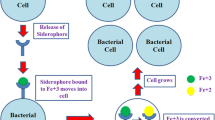Abstract
The structural gene encoding bacterioferritin comigratory protein (Bcp) was amplified using PCR from the genomic DNA of Schizosaccharomyces pombe, and transferred into the shuttle vector pRS316 to generate the recombinant plasmid pBCPlO. The bcp + mRNA level in the pBCPlO-containing yeast cells was significantly higher than that in the control yeast cells, indicating that the cloned gene is functioning. The S. pombe cells harboring the plasmid pBCPIO exhibited higher survival on the solid minimal media with hydrogen peroxide, tert-BOOH or cadmium than the control yeast cells. They also exhibited enhanced cellular viability in the liquid media containing the stressful agents. The increased viabilities of the fission yeast cells harboring the plasmid pBCP10 were also obtained with 0.4% glucose or 0.4% sucrose as a sole carbon source, and nitrogen starvation, compared with those of the control yeast cells. The total glutathione (GSH) content and total GSH/GSSG ratio were significantly higher in the yeast cells harboring the plasmid pBCP10 than in the control yeast cells. In brief, the S. pombe Bcp plays a protective role in the defensive response to oxidative stress possibly via up-regulation of total and reduced glutathione levels.
Similar content being viewed by others
References
Bast, A., G. Wolf, I. Oberbäumer, and R. Walther. 2002. Oxidative and nitrosative stress induces peroxiredoxins in pancreatic beta cells. Diabetologia 45, 867–876.
Bozonet, S.M., V.J. Findlay, A.M. Day, J. Cameron, E.A. Veal, and B.A. Morgan. 2005. Oxidation of a eukaryotic 2-Cys peroxiredoxin is a molecular switch controlling the transcriptional response to increasing levels of hydrogen peroxide. J. Biol. Chem. 280, 23319–23327.
Bradford, M.M. 1976. A rapid and sensitive method for the quantitation of microgram quantities of protein utilizing the principle of protein-dye binding. Anal. Biochem. 72, 248–254.
Fernandes, P.N., S.C. Mannarino, C.G. Silva, M.D. Pereira, A.D. Panek, and E.C. Eleutherio. 2007. Oxidative stress response in eukaryotes: effect of glutathione, superoxide dismutase and catalase on adaptation to peroxide and menadione stresses in Saccharomyces cerevisiae. Redox Rep. 12, 236–244.
Floreani, M., S.D. Skaper, L. Facci, M. Lipartiti, and P. Giusti. 1997. Melatonin maintains glutathione homeostasis in kainic acid-exposed rat brain tissues. FASEB J. 11, 1309–1315.
Gutteridge, J.M. 1993. Anthracycline toxicity, iron and oxygen radicals, and chelation therapy. J. Lab. Clin. Med. 122, 228–229.
Hofmann, B., H.J. Hecht, and L. Flohe. 2002. Peroxiredoxins. Biol. Chem. 383, 347–364.
Jeong, W.J., M.K. Cha, and I.H. Kim. 2000. Thioredoxin-dependent hydroperoxide peroxidase activity of bacterioferritin comigratory protein (BCP) as a new member of the thiol-specific antioxidant protein (TSA)/alkyl hydroperoxide peroxidase C (AhpC) family. J. Biol. Chem. 275, 2924–2930.
Kang, G.Y., E.H. Park, and C.J. Lim. 2008. Molecular cloning, characterization and regulation of a peroxiredoxin gene from Schizosaccharomyces pombe. Mol. Biol. Rep. 35, 387–395.
Kong, W., S. Shiota, Y. Shi, H. Nakayama, and K. Nakayama. 2000. A novel peroxiredoxin of the plant Sedum lineare is a homologue of Escherichia coli bacterioferritin co-migaratory protein (Bcp). Biochem. J. 351, 107–114.
Lee, S.P., Y.S. Hwang, Y.J. Kim, K.S. Kwon, H.J. Kim, K. Kim, and H.Z. Chae. 2001. Cyclophin a binds to peroxiredoxins and activates its peroxidase activity. J. Biol. Chem. 276, 29826–29832.
López-Mirabal, H.R., M. Thorsen, M.C. Kielland-Brandt, M.B. Toledano, and J.R. Winter. 2007. Cytoplasmic glutathione redox status determines survival upon exposure to the thiol-oxidant 4,4′-dipyridyl disulfide. FEMS Yeast Res. 7, 391–403.
Morishita, M., F. Morimoto, K. Kitamura, T. Koga, Y. Fukui, H. Maekawa, I. Yamashita, and C. Shimoda. 2002. Phosphatidyli-nositol 3-phosphate 5-kinase is required for the cellular response to nutritional starvation and mating pheromone signals in Schizosaccharomyces pombe. Genes Cells 7, 199–215.
Myers, A.M., A. Tzagoloff, D.M. Kinney, and C.J. Lusty. 1986. Yeast shuttle and integrative vectors with multiple cloning sites suitable for construction of lacZ fusions. Gene 45, 299–310.
Rouhier, N., E. Gelhaye, J.M. Gualberto, M.N. Jordy, E.D. Fay, M. Hirasawa, S.D. Duplessis, P. Lemaire, F. Frey, F. Martin, W. Manierl, D.B. Knaff, and J.P. Jacquot. 2004. Polar peroxiredoxin Q. A thioredoxin-linked chloroplast antioxidant functional in pathogen defense. Plant Physiol. 134, 1027–1038.
Royall, J.A. and H. Ischiropoulos. 1993. Evaluation of 2′,7′-di-chlorofluorescin and dihydrorhodamine 123 as fluorescent probes for intracellular H2O2 in cultured endothelial cells. Arch. Biochem. Biophys. 302, 348–355.
Singh, S.R., B. Pillai, B. Balakrishnan, A. Naorem, and P.P. Sadhale. 2007. Relative levels of RNA pol subunits differentially affect starvation response in budding yeast. Biochem. Biophys. Res. Commun. 356, 266–272.
Smith, M.C., E.R. Summer, and S.V. Avery. 2007. Glutathione and Gts1p drive beneficial variability in the cadmium resistances of individual yeast cells. Mol. Microbiol. 66, 699–712.
Veal, E.A., V.J. Findlay, A.M. Day, S.M. Bozonet, J.M. Evans, J. Quinn, and B.A. Morgan. 2004. A 2-Cys peroxiredoxin regulates peroxide-induced oxidation and activation of a stress-activated MAP kinase. Mol. Cell 15, 129–139.
Whitney, M.L., R.L. Hurto, H.H. Shaheen, and A.K. Hopper. 2007. Rapid and reversible nuclear accumulation of cytoplasmic tRNA in response to nutrient availability. Mol. Biol. Cell 18, 2678–2686.
Wong, C.M., Y. Zhou, R.W. Ng, H.F. Kung, and D.Y. Jin. 2002. Cooperation of yeast peroxiredoxins Tsa1p and Tsa2p in the cellular defense against oxidative and nitrosative stress. J. Biol. Chem. 277, 5385–5394.
Wood, Z.A., E. Schröder, J.R. Harris, and L.B. Poole. 2003. Structure, mechanism and regulation of peroxiredoxins. Trends Biochem. Set 28, 32–40.
Wu, C.Y., A.J. Bird, D.R. Winge, and D.J. Eide. 2007. Regulation of the yeast TSA1 peroxiredoxin by ZAP1 is and adaptive response to the oxidative stress of zinc deficiency. J. Biol. Chem. 282, 2184–2195.
Author information
Authors and Affiliations
Corresponding author
Rights and permissions
About this article
Cite this article
Kang, GY., Park, EH., Kim, K. et al. Overexpression of bacterioferritin comigratory protein (Bcp) enhance viability and reduced glutathione level in the fission yeast under stress. J Microbiol. 47, 60–67 (2009). https://doi.org/10.1007/s12275-008-0077-3
Received:
Accepted:
Published:
Issue Date:
DOI: https://doi.org/10.1007/s12275-008-0077-3




